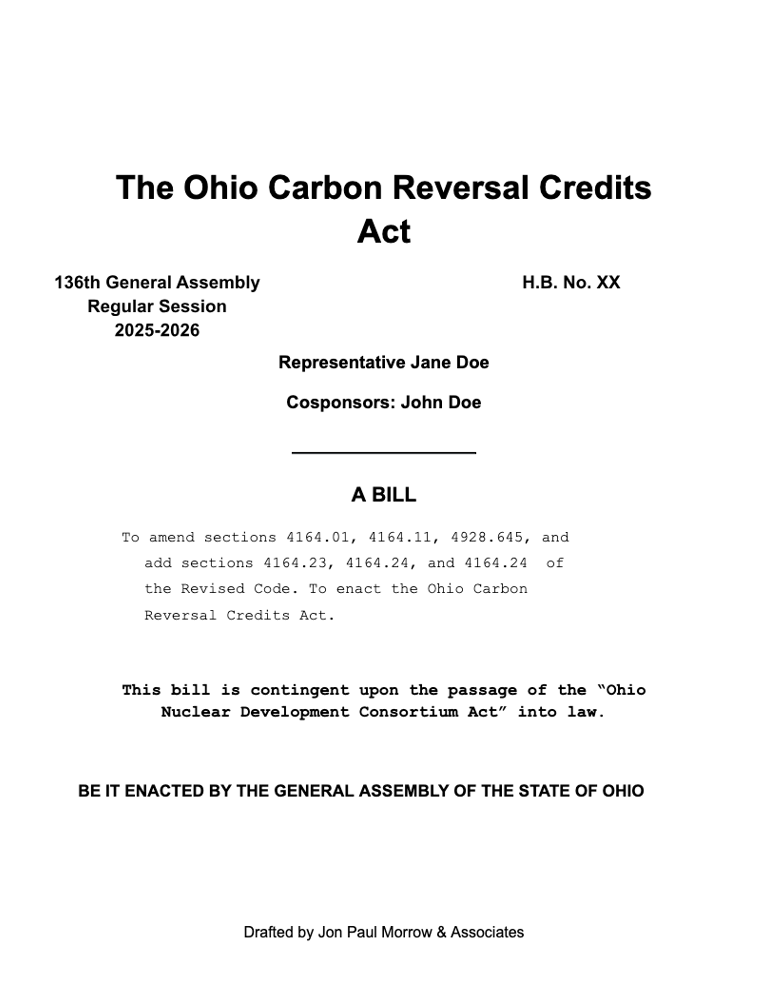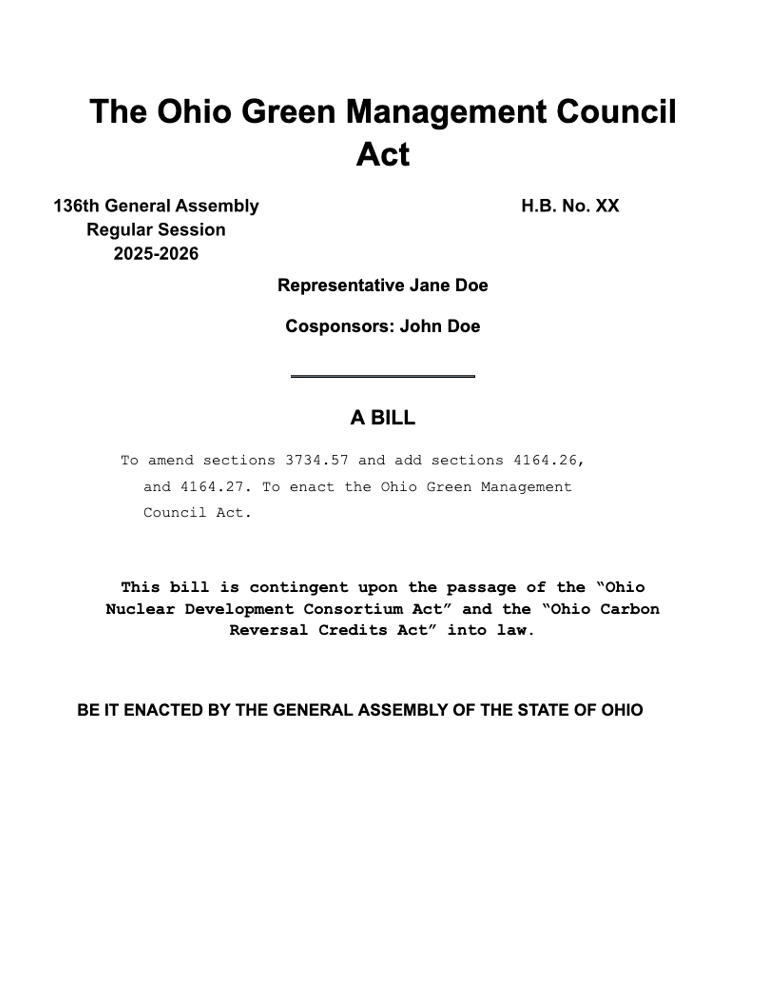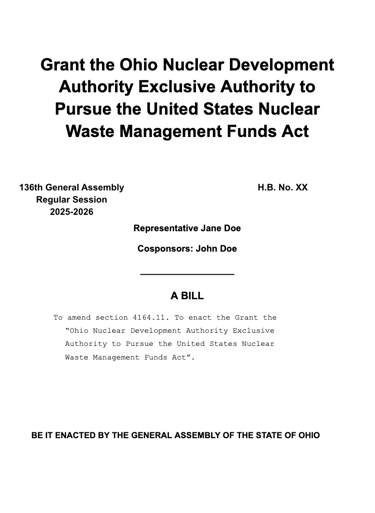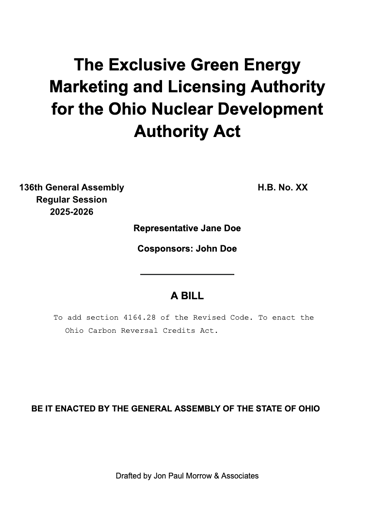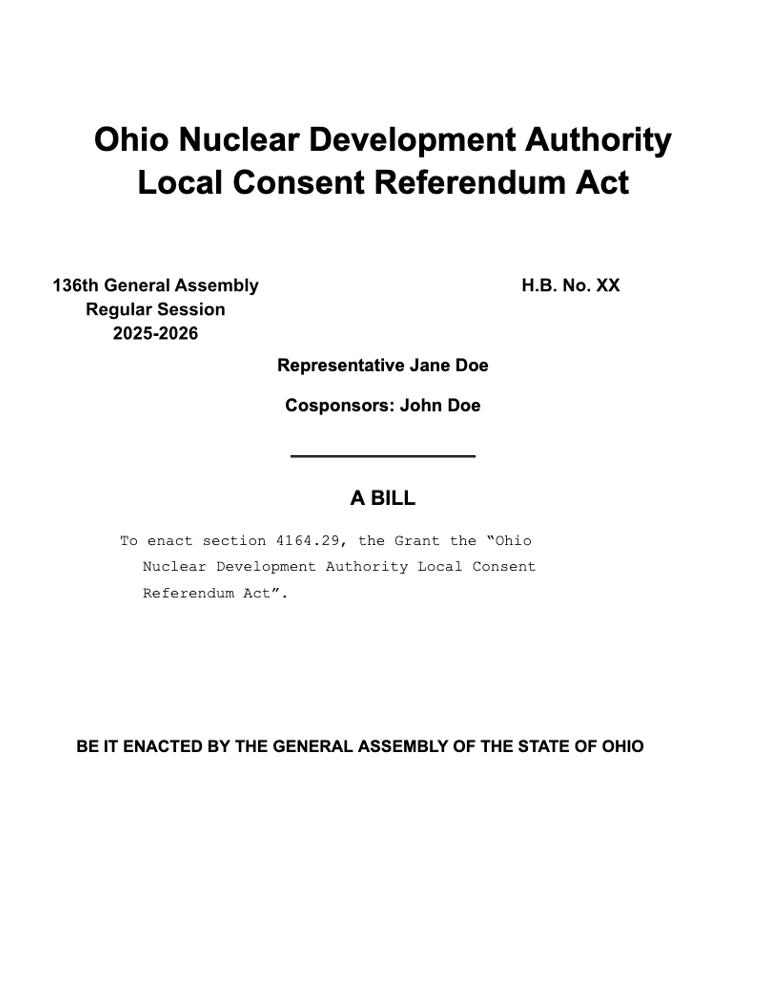Ohio Nuclear Development Consortium (ONDC)
Prepared for: Members of the Ohio General Assembly
Purpose
To establish the Ohio Nuclear Development Consortium (ONDC) as a for-profit public benefit corporation under the supervision of the Ohio Nuclear Development Authority (ONDA); to authorize the transfer of $2 billion from the Unclaimed Funds Trust to capitalize the ONDC; to permit public-private investment partnerships; to direct the Ohio Treasurer to facilitate issuance and exchange of ONDC stock; and to outline the public purposes and operational constraints of the ONDC.
Major Provisions
Establishes ONDC
Creates a new public benefit corporation to be organized by the ONDA under the Revised Code. The ONDC will be chartered to advance commercial-scale nuclear technologies and infrastructure in the state, with specific provisions outlined in its articles of incorporation.Transfers $2 billion from Unclaimed Funds
Requires the Director of Commerce to transfer $2 billion from the Unclaimed Funds Trust Fund to the ONDC. Of this amount, $200 million must be reserved in cash to pay unclaimed fund claims upon demand.Guarantees Payout of Unclaimed Funds
Mandates that ONDC honor the state’s obligation to pay out unclaimed funds held by the corporation to rightful owners upon request. Establishes a permanent minimum liquidity requirement for this purpose.1:1 Private Match Requirement
Prohibits the ONDC from using public funds for any project that does not receive at least an equal amount of private sector capital. Ensures private participation and risk-sharing in every publicly backed project.ONDA Equity Stake
Requires that ONDA maintain no less than a 10% equity ownership in the ONDC at all times. This provision is irrevocable and may not be amended or repealed.Stock Issuance and Exchange Platform
Authorizes the Ohio Treasurer to facilitate the issuance, trading, and exchange of ONDC stock, including through traditional offerings or digital tokenized securities. Permits the ONDC to issue up to $8 billion in stock (2025 dollars) through 2030, with further issuance allowed thereafter.Public Benefit Mandate
Declares that ONDC’s corporate purpose shall include:Consuming spent nuclear fuel and reducing nuclear waste stockpiles;
Producing valuable isotopes for medicine, industry, and national defense;
Plasma gasification of municipal solid waste into clean fuels;
Supporting Ohio’s electricity supply with carbon-negative energy sources;
Designing and exporting modular nuclear reactors built in Ohio.
Fiscal and Policy Implications
Leverages Dormant Capital
Utilizes existing, idle unclaimed funds to catalyze private-sector investment in high-value industrial infrastructure without increasing taxes or public debt.Revenue Generation Potential
Enables the state to participate in commercial ventures that may yield dividends and increased fund balances, with returns accruing to both the state and the rightful owners of unclaimed property.Decarbonization and Energy Security
Supports long-term energy independence and emissions reductions by expanding advanced nuclear technologies and processing capacity in-state.Economic Development
Positions Ohio as a national leader in fast-spectrum molten salt reactors, advanced isotope production, and waste-to-energy commercialization, while attracting new manufacturing, engineering, and research jobs.
Carbon Reversal Credits Act
Purpose
This legislation amends and expands the powers of the Ohio Nuclear Development Authority (ONDA) to fund its operations and accelerate investment in advanced nuclear technologies by issuing Carbon Reversal Credits (CRCs) and membership shares to regulated energy providers. The Act creates new mechanisms within the Revised Code to support nuclear energy innovation, meet Ohio’s Renewable Portfolio Standard (RPS), and foster grid resiliency.
Major Provisions
Creation of Carbon Reversal Credits (CRCs):
The ONDA is authorized to issue CRCs as a new form of Renewable Energy Credit. CRCs may be used by electric distribution utilities (EDUs) and competitive retail electric service (CRES) providers to fulfill RPS obligations under R.C. 4928.645.Membership Shares Requirement:
EDUs and CRES providers are required to annually purchase up to 4,000 ONDA membership shares at $50 each in 2025 constant dollars. For each share, 12 CRCs are awarded. These funds support ONDA operations and incentivize private-sector investment into the Ohio Nuclear Development Consortium (ONDC).Investment Matching and Additional CRCs:
After meeting the membership share threshold, entities may earn one additional CRC per dollar invested in the ONDC and ONDC projects, effectively linking public-private capital to Ohio’s clean energy targets.Revenue Use and Funding Caps:
ONDC may contribute up to 0.5% of its outstanding stock’s face value annually to fund ONDA operations, while retaining up to 2% annually for its own administrative needs.Establishment of Energy Reliability Council of Ohio:
A 19-member advisory council is created within ONDA, composed of the largest stakeholders based on membership shares and investments. This council advises ONDA and the legislature on policies to enhance electric grid reliability and cost containment.Integration with RPS Compliance:
Amends R.C. 4928.645 to include CRCs issued by ONDA as eligible Renewable Energy Credits, usable toward RPS compliance over a five-year period following issuance.
Impact
This bill introduces a market-based approach to financing Ohio’s nuclear development strategy. It provides a new compliance pathway for power providers under the state’s renewable standards while attracting private capital and enhancing energy security. CRCs are designed to reward investment in carbon-negative technologies, including nuclear waste-consuming reactors and advanced plasma gasification, positioning Ohio as a national leader in next-generation clean energy.
The Ohio Green Management Council Act
Summary of the Bill
This legislation amends section 3734.57 of the Ohio Revised Code. It enacts new sections 4164.26 and 4164.27 to establish a dedicated funding and advisory framework for advanced waste management technologies and environmental stewardship through the Ohio Nuclear Development Authority (ONDA). It is contingent upon the prior enactment of the Ohio Nuclear Development Consortium Act and the Ohio Carbon Reversal Credits Act.
Major Provisions
New $4.00 per Ton Tipping Fee
Adds a $4.00 per ton disposal fee on municipal solid waste in Ohio. Proceeds are deposited into a newly created Ohio Green Management Fund to support the development of nuclear-powered plasma gasification technologies and related waste-to-energy research initiatives.Expanded ONDA Membership and Credit Incentives
Authorizes membership in the Ohio Nuclear Development Authority for municipal solid waste firms, coal-related industries, and syngas or chemical conversion entities.Eligible firms may purchase up to 4,000 ONDA membership shares.
Each share earns 12 Carbon Reversal Credits (CRCs).
After the share cap is reached, investors may earn one CRC for every $1 invested in ONDC or related projects.
Creation of the Ohio Green Management Council (OGMC)
Establishes the OGMC as a standing advisory body under the ONDA:Charged with advising the ONDA and General Assembly on policies related to waste management, environmental cleanup, and emissions reduction.
Composed of all ONDA members as ex officio participants.
Includes 10 top contributing non-utility ONDA members, selected based on investment in ONDC projects.
ONDA sets the OGMC’s bylaws and constitution and resolves internal disputes.
Intent and Impact
The bill aims to establish a consistent and non-taxpayer-based funding mechanism to accelerate the commercialization of plasma gasification and waste-to-energy systems in Ohio. It strengthens public-private collaboration by rewarding industrial membership and investment through a newly created carbon credit structure. Furthermore, it establishes a structured advisory council with both regulatory and industry representation to ensure Ohio’s long-term leadership in carbon-negative waste remediation technologies.
Grant the Ohio Nuclear Development Authority Exclusive Authority to Pursue the United States Nuclear Waste Management Funds Act
Purpose:
To amend Section 4164.11 of the Ohio Revised Code to expand the statutory powers of the Ohio Nuclear Development Authority (ONDA), granting it exclusive authority to pursue federal funds from the United States Nuclear Waste Management Fund (USNWMF) through lobbying, litigation, and intergovernmental coordination. This legislation positions ONDA as the state’s lead entity in managing advanced nuclear reactor technologies aimed at consuming or storing spent nuclear fuel.
Key Provisions:
Exclusive Representation:
Grants ONDA exclusive authority among all Ohio state agencies to engage in lobbying, litigation, and deliberations to obtain access to the USNWMF for the purpose of reducing or storing Ohio’s nuclear waste using advanced reactor technologies.Legal Support:
Authorizes ONDA to request assistance from the Ohio Attorney General for litigation and legal barriers that may arise in pursuit of nuclear waste funding or related regulatory activities.Funding Eligibility:
Empowers ONDA to apply for and secure federal matching funds from the USNWMF for any project that consumes spent nuclear fuel or establishes permanent nuclear waste storage within Ohio.
Fiscal and Policy Impact:
Federal Cost-Share Leverage:
Enhances Ohio’s competitiveness for federal nuclear waste funds that have previously gone untapped, unlocking matching dollars for in-state innovation and waste reduction solutions.Improved Coordination and Efficiency:
Establishing ONDA as the sole representative reduces duplication of efforts across agencies and ensures a unified strategy in accessing federal resources.Grid Reliability and Environmental Stewardship:
Supports Ohio’s long-term goals to manage nuclear waste responsibly while enabling the development of carbon-free energy through fast-spectrum molten salt reactor technologies.
Background:
The United States Nuclear Waste Management Fund holds billions in Ohio ratepayer-contributed assets intended for the safe disposal and consumption of spent nuclear fuel (SNF). Ohio currently has no active mechanism or representative body with dedicated access to these funds. By assigning ONDA this authority, the bill potentially helps facilitate Ohio’s entry into the next generation of advanced nuclear technologies and waste solutions.
Legislative Intent:
To make Ohio a national leader in advanced nuclear development by enabling ONDA to strategically pursue resources and partnerships necessary to eliminate the state’s legacy nuclear waste burden while accelerating innovation in carbon-free, grid-resilient technologies.
The Exclusive Green Energy Marketing and Licensing Authority for the Ohio Nuclear Development Authority Act
Summary of What the Bill Does:
This bill grants the Ohio Nuclear Development Authority (ONDA) exclusive authority over the use of the marketing terms "Green Energy," "Greener than Green Energy," and "Carbon Reversal Technology" within the state of Ohio. It creates a formal licensing framework through which electric distribution utilities (EDUs) and competitive retail electric service (CRES) providers may apply to use these terms. To qualify, companies must invest in Carbon Reversal Credits (CRCs) or related emissions-reducing technologies and display a mandatory disclaimer.
The bill also prohibits EDUs and CRES providers from advertising that their energy is “100% renewable” unless they actually generate 100% of their energy from renewable sources and procure all associated renewable energy credits (RECs) from facilities located within Ohio. Otherwise, providers must include a disclaimer clarifying that their claims are based on out-of-state RECs and do not reflect actual energy generation.
Key Provisions:
Grants ONDA exclusive rights to license specific green energy terminology in Ohio.
Requires licensed entities to display a disclaimer:
“This company invests in Carbon Reversal Credits that are used to develop carbon reversal technology.”Prohibits misleading claims about “100% renewable energy” without factual in-state REC backing.
Establishes penalties:
$3/MWh civil penalty for each violation.
Third-degree felony liability for knowingly complicit corporate officers.
Creates an appeal mechanism through the Public Utilities Commission of Ohio (PUCO) for any adverse actions taken by ONDA.
Purpose and Legislative Intent:
This legislation is intended to:
Establish a regulatory standard for green energy terminology use in Ohio.
Create market parity between nuclear-derived carbon-negative energy and traditional renewables.
Encourage private investment in advanced nuclear and carbon-reversal technologies.
Prevent consumer misrepresentation regarding energy sourcing and the nature of green energy products.
Local Consent Referendum Authorization for Ohio Nuclear Development Authority Projects Act
Summary of What the Bill Does:
This bill authorizes boards of county commissioners or county executives in the state of Ohio to place two types of legally binding referendums before voters regarding Ohio Nuclear Development Authority (ONDA) projects:
A general consent referendum indicating that the county consents to doing business with the ONDA.
A specific consent referendum for projects involving the use of nuclear materials.
This statutory framework enables local governments to proactively signal market interest and community readiness to host ONDA-affiliated energy and waste remediation projects, whether nuclear or non-nuclear. It also serves as a mechanism for democratic buy-in, transparency, and public participation in advanced energy infrastructure development.
Key Provisions:
Permits counties to place a general referendum on the ballot to express consent to engage in business with the ONDA.
Allows for a second, specific referendum to approve or reject individual projects involving nuclear materials.
Requires that:
The ONDA approves the ballot language for both types of referenda.
The local board of elections confirms the accuracy and truthfulness of the ballot language for nuclear-related projects. The local board of elections may reject the ONDA language
Mandates public notice in the local newspaper of record at least 60 days prior to the start of early voting.
Requires a public hearing to be held at least 30 days prior to the start of early voting.
Referendums may only be held during even-numbered general elections for maximum voter participation.
Petitions for referendums must be submitted at least 90 days prior to the start of early voting.
Purpose and Legislative Intent:
The legislation establishes a formal avenue for local governments to participate in state-led nuclear and waste-to-energy initiatives while maintaining local autonomy. It sends a strong signal to investors, developers, and the federal government that communities are prepared to engage in high-tech energy development in partnership with the ONDA.
By creating this structured consent process, the bill enhances transparency, strengthens public trust, and supports responsible siting of nuclear and related projects—ultimately advancing energy innovation, grid reliability, and environmental stewardship in Ohio.



